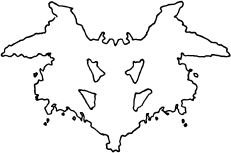
Most people have heard of the Rorschach test, but few have ever seen a real Rorschach inkblot. The blots are kept secret. When you see an inkblot in a popular article on the test (as in the Encyclopaedia Britannica entry on the Rorschach test), it’s a fake: an inkblot, but not one of the inkblots. There are only ten Rorschach inkblots.
Psychologists want the blots to remain a secret from the general public so that reactions to the blots will be spontaneous. Hermann Rorschach hoped these spontaneous reactions would yield valuable clues to the test subject’s personality. Whether they do remains controversial. Many psychologists think the Rorschach test is hopelessly unreliable; others see it as one of the cardinal tools of modern psychodiagnosis. Even among those who acknowledge the value of the test, there is disagreement on interpretation of responses.
Just as secret as the blots themselves are the ground rules for administering the test. There are a few things that you, as a subject, are supposed to know and a lot of things you aren’t supposed to know. If you ask about something you’re not supposed to know, the psychologist will give you a pat answer as prescribed in Rorschach literature. For example, if you ask if it is okay to turn the card upside down, the psychologist will respond that you may do as you like; it’s up to you. The psychologist won’t say that many of the cards are easier to interpret when turned; that most people do turn the cards; that he or she will make a notation with a little arrowhead every time you do turn a card; and that you lose points in the initiative department if you don’t turn the cards.
You’ll be handed the cards one by one in the fixed order devised by Rorschach (there are numbers on the backs of the cards for the psychologist’s benefit). The first card, for instance, looks like a fox’s head or a jack-o’-lantern. The cards are thick, rectangular cardboard, 65/8 inches by 9½ inches. Half of the blots are black ink on a white background. Two others are black and red ink on white, and the last three blots are multicolored. The psychologist will always put each card in your hands “right” side up.
You aren’t supposed to know it, but the psychologist will write down everything you say. This includes any seemingly irrelevant questions you may have. To keep you from getting wise, the psychologist always arranges to sit to your side and a little behind you, so that you can’t look at the card and the psychologist at the same time. Most subjects realize the psychologist is taking notes, of course, but they don’t realize that the notes are a special shorthand record of everything said. Some psychologists use hidden tape recorders.
The psychologist will also time how long it takes you to respond, using a “tickless” watch. The psychologist will not ask you to hurry up or slow down and will not make any reference to time, but response times (in seconds) are one of the things he or she is writing in the notes.
Don’t hold the card at an unusual angle. Watch how you phrase things. Say “This looks like …” or “This could be … ”never “This is …” After all, you’re supposed to realize that it is just a blot of ink on a card. By the same token, don’t be too literal and say things as, “This is a blotch of black ink.” Don’t groan, get emotional, or make irrelevant comments. Don’t put your hands on the cards to block out parts. The psychologist will watch for all of the foregoing as signs of brain damage.
If there are no right answers for the test, there are some general guidelines as to what is a normal response. You can probably see images in the inkblots proper and in the white spaces they enclose. Stick to the former. Don’t be afraid of being obvious. There are several responses that almost everyone gives; mentioning these shows the psychologist you’re a regular guy.
It is okay to be original if you can justify what you see in the shape, shading, or color of the blot. If you see an abalone and can point out why it looks like one, then say so. Justifiable original responses are usually judged to be indicative of creativity or intelligence. You don’t want non sequiturs, images that don’t fit the blot in the judgment of the psychologist. These may be signs of psychosis.
You’re expected to see more than one thing on all or most of the cards. Not being able to see anything on a card suggests neurosis. Usually the more things you can see, the better, as long as they fit the form and color of the blot. Of course, you can see things in the whole blot or in parts of it, and images may overlap.
Since time is a factor, it is important to come up with good answers fast. (It looks particularly bad if you take a long time and give a dumb, inappropriate answer.) The most reliable way to come up with good answers is to memorize what the good answers are. Copyright restrictions prevent us from showing you the blots themselves, so we’ll use outlines. We’ll refer to the blots as psychologists do, as Plates I through X. The psychologist won’t mention the numbers to you, but the blots will always be in order.

Black ink. A roughly triangular shape, point down, suggesting a broad, fox like face with prominent ears. Naughty bits: a pair of breasts (rounded projections at top of blot); a vertical female figure, her torso partly visible through a gauzy dress (along center line).
The first blot is easy. How fast you answer is taken as an indication of how well you cope with new situations. The best reaction is to give one of the most common responses immediately. Good answers are bat, butterfly, moth, and (in center of blot) a female figure. Mask, jack-o’-lantern, and animal face are common responses too, but in some interpretation schemes they suggest paranoia. A bad response is any that says something untowardabout the central female figure. “She” is often judged to be a projection of your own self-image. Avoid the obvious comment that the figure has two breasts but no head.
If you don’t give more than one answer for Plate I, many psychologists will drop a hint—tell you to look closer.
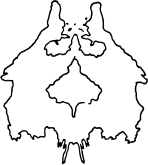
Black and red ink. Two dark-gray splotches suggesting dancing figures. Red splotches at top of each figure and at bottom center. Naughty bits: penis (upper center’ black ink); vagina (the red area at bottom center).
It is important to see this blot as two human figures—usually females or clowns. If you don’t, it’s seen as a sign that you have trouble relating to people. You may give other responses as well, such as cave entrance (the triangular white space between the two figures) and butterfly (the red “vagina,” bottom center).
Should you mention the penis and vagina? Not necessarily. Every Rorschach plate has at least one obvious representation of sexual anatomy. You’re not expected to mention them all. In some interpretation schemes, mentioning more than four sex images in the ten plates is diagnostic of schizophrenia. The trouble is, subjects who took Psychology 101 often assume they should detail every possible sex response, so allowances must be made. Most Rorschach workers believe the sex images should play a part in the interpretation of responses even when not mentioned. You may not say that the lower red area looks like a vagina, but psychologists assume that what you do say will show how you feel about women. Nix on “crab”; stick with “butterfly.”
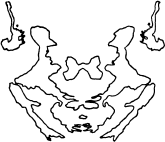
Black and red ink. Two obvious figures (black ink) facing each other. Butterfly-shaped red blot between the figures; an elongated red blot behind each figure’s head. Naughty bits: penises and breasts (at anatomically appropriate positions for each figure).
This is the blot that supposedly can determine sexual preference. Most people see the two human figures. Both figures have prominent “breasts” and an equally prominent “penis.” If you don’t volunteer the gender of the figures, you’ll be asked to specify it. By the traditional interpretation, seeing the figures as male is a heterosexual response (for test subjects of both sexes). Describing the figures as female or acknowledging the androgynous nature of the blot is supposed to be a homosexual response. Does it work? Not really—many straights describe the figures as women, and not all gays give a gay response. A 1971 study at Mount Sinai Hospital in New York showed the traditionally heterosexual response (two male figures) to be declining in popularity.
The splotches of red ink are usually perceived separately. Common responses are bow tie or ribbon (inner red area) and a stomach and esophagus (outer red areas).
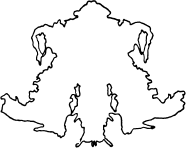
Black ink. A roughly triangular blot, point up, with the two lower corner regions resembling boots or feet. Naughty bits: two penises (on either side of blot, near top of triangle); vagina (on center line near top of blot).
Plate IV is the “father card.” At first glance it is a difficult blot to see as a single image. The “boots” are fairly conspicuous; between them is the apparent head of a dog or Chinese dragon. Many subjects see the blot as an animal skin. After a few seconds, though, most can see it as a standing figure seen from below. The boots become the feet, enlarged because of the unusual perspective. The arms and head, at the top, are smaller. Common descriptions are bear, gorilla, or man in a heavy coat. Bad descriptions are monster or attacking bear or gorilla—Rorschach theorists equate your description of the figure with your perception of your father or male authority figures.

Black ink. A simple, batlike shape. Naughty bits: two penises (the “ears ‘ or “antennae”).
Rorschach himself thought this was the easiest blot to interpret. It is a bat or a butterfly, period. You don’t want to mention anything else. Seeing the projections on the ends of the bat wings as crocodile heads signifies hostility. Seeing the paired butterfly antennae or feet as scissors or pliers signifies a castration complex. Schizophrenics sometimes see moving people in this blot.
Many psychologists take particular note of the number of responses given to this plate. If you mention more images here than in either Plate IV or VI, it is suggestive of schizophrenia
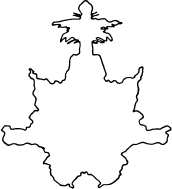
Black ink. An irregular shape like that of an animal-skin rug. Naughty bits: penis (center line at top); vagina (below penis).
Plate VI is the most difficult blot. The best-rendered penis of all the blots is at top, but few subjects mention it. The rest of the blot doesn’t look like much of anything. Some hold that the value of this blot is to have the subject grope for images and possibly reveal subconscious attitudes about sexuality.
Basically, the secret of this plate is to turn it. A good response is to say it looks like an animal hide (about the only reasonable response when held right side up), then turn it on its side and say it looks like a boat or surfaced submarine with reflection, and then turn it upside down and say it looks like a mushroom cloud, a pair of theater masks, or caricatures of men with long noses and goatees.
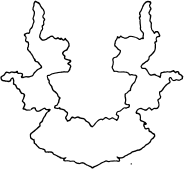
Black ink. A U-shaped blot, each side of the U resembling a female figure in a narrow-waisted dress. Naughty bits: a vagina (on center line at bottom of U).
Christina Crawford meets projective psychology: This blot is supposed to reveal how you really feel about your mother. Virtually everyone sees two girls or women. Deprecating descriptions of the figures—“witches,” “gossips,” “girls fighting,” “spinsters”—indicate poor maternal relations. Seeing the blot as thunderclouds instead of female figures suggests anxiety to some psychologists; seeing it as a walnut kernel may mean a vulvar fixation.
There is an entirely different side to this blot, but you’re not supposed to see it. The white space between the girls or women can be interpreted as an oil lamp or similar object. It is claimed that only schizophrenics usually see the lamp.
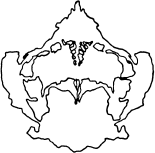
Pink, blue, gray, and orange ink. An almost circular array of interconnected forms—a gray triangle (point up) at top, a pair of blue rectangles in the center, a pink and orange splotch at bottom, and two pink “animal” shapes forming the right and left sides of the circle. Naughty bits: a vagina (pinkorange area at bottom).
The first full-color card is easy. It is important that you see the four-legged animals—lions, pigs, bears, etc.—on the sides of the blot. They’re one of the most common responses on the test, and you’re assumed to be a mental defective if you don’t see them. Other good responses are tree (gray triarigle at top), butterfly (pink and orange area at bottom), and rib cage or anatomy chart (skeletal pattern in center between blue rectangles and gray triangles). The entire configuration can be seen as a heraldic design (good answer) or a Christmas tree with ornaments (reaching). Children tend to like this blot and say a lot about it—the bright colors and animal shapes make it more interesting than your basic penis/vagina number (II, IV, or VI).
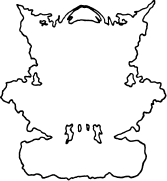
Green, orange, and pink ink. A very irregular upright rectangle. Orange at top, protruding green areas at center, pink at bottom. Naughty bits: a vagina (center line at bottom).
There aren’t many good answers here. If you’re going to throw up your hands (figuratively; see warning about emotional outbursts above) and plead a mental block, this is the place to do it.
The colors clash, apparently by Rorschach’s design. Good answers are a fire with smoke, an explosion (but paranoids are claimed more apt to note the pale green mushroom cloud on the center line at top), a map, anatomy, or a flower. If you turn the card ninety degrees, you can make out a man’s head in the pink areas at bottom. (The man is identified as Mark Twain, Santa Claus, or Teddy Roosevelt.) A bad response is to describe the orange areas at top as monsters or men fighting—a sign of poor social development. As with Plate V, the psychologist may be counting the number of responses you give to this blot for comparison with the preceding and succeeding blots. You want to give fewer responses to this blot.
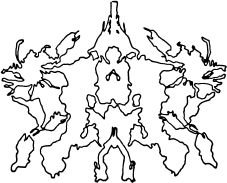
Pink, blue, gray, green, yellow, and orange ink. A loose assortment of brightly colored shapes, the most chaotic of the plates. Naughty bits: penis and testes (top center, gray ink).
The unspoken purpose of this last blot is to test your organizational ability. Plate X is full of colorful odds and ends easy to identify—blue spiders, gray crabs, paired orange maple seeds, green caterpillars, a light-green rabbit’s head, yellow and orange fried eggs—and you’re expected to list them. But the psychologist will also be looking for a comprehensive answer, something that shows you grok the whole Gestalt. There are two good holistic answers: sea life and a view through a microscope.
Some subjects see two reddish faces at top center, separated by the orange maple key. If you describe them as blowing bubbles or smoking pipes, it may be interpreted as evidence of an oral fixation. Seeing the gray “testes” and “penis” as two animals eating a stick or tree indicates castration anxiety.